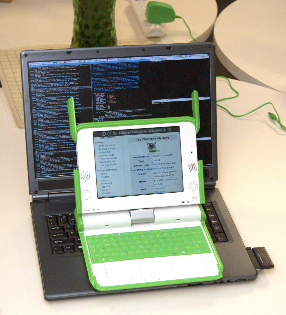Emulating the XO: Difference between revisions
m (writing a little more.) |
|||
| Line 26: | Line 26: | ||
== Build recommendations == |
== Build recommendations == |
||
For running XO disk images on an emulator, you must use an '''ext3''' image, not the [[JFFS2]] image which is for on-board NAND flash memory. Please note that the current stable release and the latest developer build |
For running XO disk images on an emulator, you must use an '''ext3''' image, not the [[JFFS2]] image which is for on-board NAND flash memory. Please note that the current stable release is available only in [[JFFS2]] and the "latest" developer build may not yet be usable in ext3 at this time. So please check some older builds. Some builds are better than others and the most recent one will not always work. |
||
Here is a summary of current status. Please add your own experiences here, and in [[User Feedback on Images]]. |
Here is a summary of current status. Please add your own experiences here, and in [[User Feedback on Images]]. |
||
Revision as of 09:54, 20 January 2008
| modify |
Emulators allow you to run a "virtual machine" on a (reasonably powerful) host machine. There are a number of emulator systems available which can be used to run a simulated OLPC-XO.
Strictly speaking, what is emulated is not an XO laptop itself but simply a generic x86 PC on which the XO system software may run, therefore this emulation is hardly faultless in itself. Further, the customized devices on XO latop can not be emulated and some peripherals in your PC may not be supported through the "emulated" XO.
See the Developer's Manual for a discussion of the general merits of the various packages and the ways you might want to use emulation in the development process. Always keep in mind that emulation is NOT perfect.
See Comparison of Alternatives for a grid showing which environments have been tested and found to work on which host operating systems.
- Configuration and Usage
- Tutorial on how to get this working.
- Improving emulation
Emulators
At present, QEMU is mainly used.
If you are running linux, there is an experimental package to simplify using qemu for emulation. Feedback encouraged. MitchellNCharity 15:03, 6 January 2008 (EST)
Build recommendations
For running XO disk images on an emulator, you must use an ext3 image, not the JFFS2 image which is for on-board NAND flash memory. Please note that the current stable release is available only in JFFS2 and the "latest" developer build may not yet be usable in ext3 at this time. So please check some older builds. Some builds are better than others and the most recent one will not always work.
Here is a summary of current status. Please add your own experiences here, and in User Feedback on Images.
Current joyride builds generally work (as of ~1400). Presence service (mesh view and collaboration) wont work by default, because they are configured with a presence service providing jabber server of ship2.jabber.laptop.org, which doesn't yet exist. There is an overloaded and fragile jabber.laptop.org which may be used in the meantime. -- MitchellNCharity 22:42, 14 December 2007 (EST)
- Another jabber server alternative is: jabber.xochat.org (typically 60 to 80 people online) --IainD 03:29, 5 January 2008 (EST)
- Please be aware that the xochat.org server is also overloaded, and the load is proportional to the product of the number of registrees times the current number of users, for the reasons documented at XMPP_Extensions. So don't connect (and thus automatically register) unless you will really be contributing, and/or set up your own ejabberd server. NealMcBurnett 15:39, 7 January 2008 (EST)
I've had good luck with all of the ship2 builds under VMware Workstation 6. -- Ed Borasky (Znmeb), 15 December 2007.
External links
- Sugar, the XO laptop, and One Laptop per Child, M. Tim Jones. developerWorks. IBM, 2007-04-24.
